What are turtle terrariums and how to equip them?
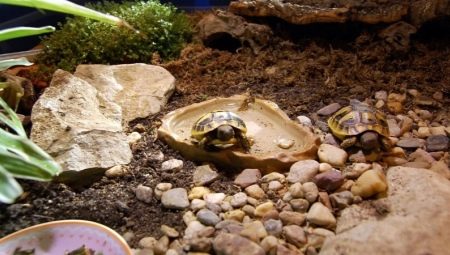
The key to a comfortable life for any pet is human-created favorable conditions. Reptiles in this case are no exception. That is why you should know what terrariums are for different types of turtles, and how to properly equip them.
It is important to remember that such structures and their equipment are a kind of imitators of the natural environment for animals kept at home.
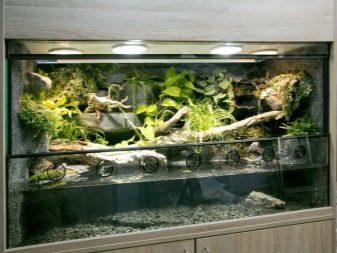
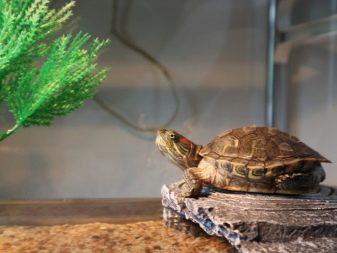
Views
At their core, the vast majority of terrariums are transparent structures. They are intended for keeping heat-loving reptiles and amphibians, which, in turn, are not able to fully exist in the conditions of modern houses and apartments. In terrariums for water and land turtles, an appropriate microclimate is created. But it should also be borne in mind that they are most often not only the dwelling of animals, but in parallel they perform the functions of beautiful elements of the interior of a particular room.
It should be noted that today there are several varieties of the described structures. Moreover, they are classified taking into account the shape, material of manufacture, size and purpose.
A specific model is selected individually, taking into account the peculiarities of the type of turtles. This is true both for the terrarium itself and for equipping and decorating it.
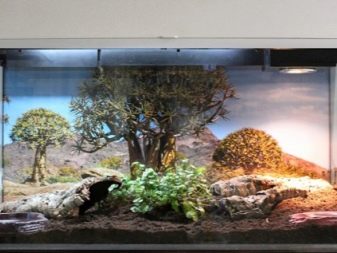
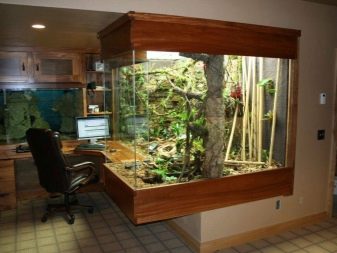
By material
Often turtle aquariums and terrariums are made from ordinary silicate or acrylic glass... In the first case, we are talking about a material characterized by a relatively high wear resistance.As practice shows, it does not scratch like plexiglass as a result of fairly frequent cleaning of reptile dwellings. In addition, ordinary glass, due to its low thermal conductivity, makes it possible to provide a favorable microclimate for turtles. However, it should be noted that animals often do not notice the transparent walls of terrariums and fight against them. The use of an aquarium background allows you to minimize the risk of injury. In this case, only the opening part is often left transparent.
Plexiglas is a type of plastic that transmits light well. In addition, the material is characterized by resistance to damage and stress, as well as environmental friendliness. An equally important point is that the plastic structure is guaranteed to be lighter than glass. By the way, even a plastic food container of the appropriate size is suitable for small individuals of aquatic species. In situations with land turtles, wooden structures can be used.

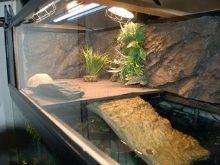
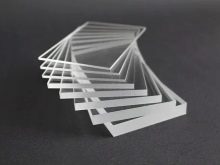
To size
Analyzing the variety of terrariums currently on the market for the described category of reptiles, in the context of shape and size, it is worth highlighting the following options.
- Horizontal - in this case, the length and width of the structure will be at least 2 and 1.5 times its height, respectively.
- Vertical models - the height of the structure is twice or more its length and width, which are often practically the same. It should be noted that such terrariums are more focused on the maintenance of land reptiles that prefer to move through trees and vertical surfaces.
- Cubic - terrariums, the linear dimensions of which are almost identical. Such versions can be called universal.
To understand how large or small a terrarium is needed in any particular case, it is necessary to consider the potential size of its inhabitant or inhabitants. It is important to remember the freedom of movement of residents.
The best option is when the size of the dwelling is 3-5 times larger than the parameters of the inhabitants. Of course, the number of occupants must also be taken into account.

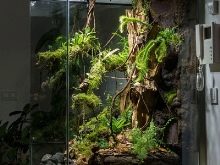

Necessary equipment
Regardless of what kind of representative will settle in the terrarium, it must be properly equipped. It is important to provide conditions for the reptile that would be as close as possible to its natural habitat.
And also do not forget about the design of such structures. As already noted, in most cases, terrariums with and without pedestals also perform a decorative function, becoming elements of interiors.
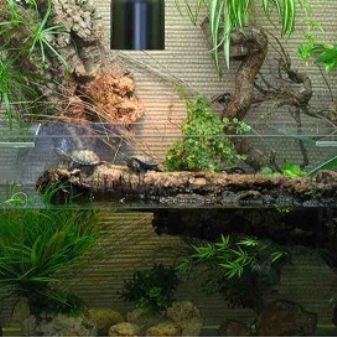

Ventilation
Very often in practice, reptile owners try to cover terrariums and aquariums with lids with holes. The main purpose of these devices is to prevent the turtles from trying to get out. But here it is important to take into account that the penetration of fresh air is significantly limited. Insufficient aeration of the terrarium becomes the cause of stagnation and, most importantly, the accumulation of gases emitted by animals in the lower part of it. Adequate ventilation will provide good ventilation and help rid the interior of hazardous carbon dioxide.
Predictably, solutions to problems in situations with water and land turtles will have certain differences and characteristics. So, in the second case, we are talking about the organization of effective ventilation due to thermal convection. This requires holes in the lower and upper parts of the walls of the terrarium through which the air will circulate. If we mean ventilation of an aquarium or aquaterrarium for a water turtle, then the perforation of the lid alone will not be enough. The most rational solution in this case would be the use of special compressors. These simple and affordable devices effectively and quickly enrich the water in the tank with air.
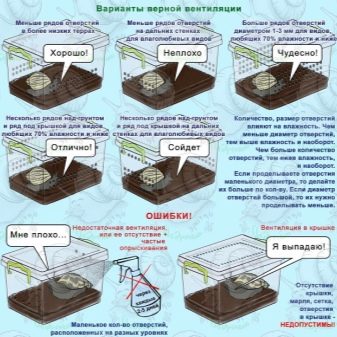
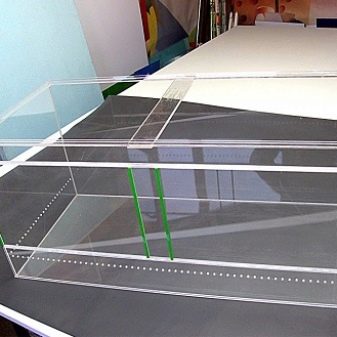
Priming
In this context, attention should be focused on land turtles and their maintenance at home. It is important to take into account that many representatives of such species spend a lot of time digging in or, in general, in burrows. If these reptiles are placed in a terrarium without proper filler, then you may encounter problems such as stress, abrasion of claws, carapace tuberosity and other unpleasant phenomena. Based on these features of the lifestyle of animals, you should provide the burrowing turtles with appropriate conditions, while in other cases it will be possible to do with rugs on the bottom. But it is important to remember that the soil in the terrarium and aquarium should be as safe, absorbent and, importantly, harmless as possible, even if eaten. It is unacceptable that the filler:
- dusty;
- contains toxic components;
- irritated the mucous membranes of the animal.
In addition to all of the above, according to current requirements, the soil should simulate as much as possible the natural habitat of a particular reptile. That is why it is difficult to single out the best and most versatile filler options.
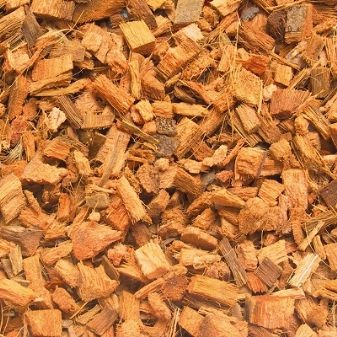

Lighting and heating
It is important to immediately note here that the usual daylight for reptiles is categorically lacking. Based on this, it will definitely be necessary to provide additional sources of both lighting and heat with the help of appropriate lamps and other devices. In the first case, we are talking about ultraviolet radiation. The next important point is maintaining the required temperature in the terrarium. Turtles are cold-blooded fauna, and, therefore, almost all processes in their body are determined by the microclimate. In situations with aquatic species, it will be necessary to maintain the water temperature at 26-30 degrees using heating elements.
Among other things, in a turtle dwelling, a so-called warm corner should be equipped. In this zone, a heating lamp is installed at a height of 20-30 cm from the animal's shell. The thermometer in this corner should rise to around 30-32 degrees.
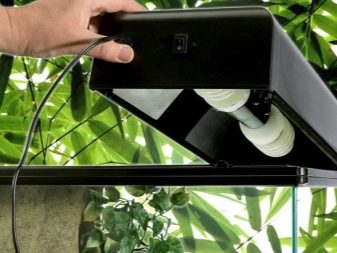
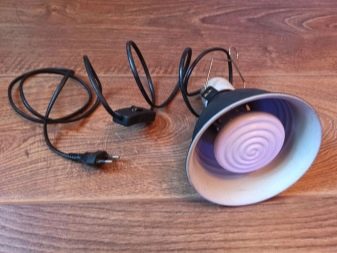
Features of arrangement for different turtles
The main task of any terrarium is to mimic the natural habitat. This is true both for the red-eared, marsh and other species of aquatic reptiles, as well as for the Central Asian and other land turtles.
It is important to properly equip the home for such unusual pets. It should be comfortable for the inhabitants. To create favorable conditions, a whole arsenal of special devices, fillers and accessories is used.
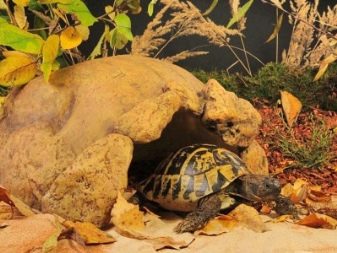

For land
The size of the terrarium should be chosen taking into account the size and number of potential inhabitants. In a simplified form, you can calculate the required parameters, taking into account that the dwelling should be 2-6 times more residents. A turtle in a terrarium should have:
- air heating lamp;
- UV lamp;
- thermometer;
- priming;
- shelter;
- equipped feeding area;
- shallow bathing water tank.

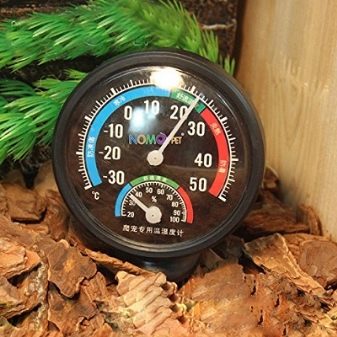
Particular attention should be paid to soil selection in land animal situations. It is important to remember that this filler is not only a decorative element. It is also about the absorption of waste products of the inhabitants of the terrarium. In addition, good quality soil will help prevent damage to the turtle's limbs. The main thing is that it does not become dusty and does not pose a potential health hazard to pets. At the moment, the best options are:
- alder chips;
- straw;
- hay;
- sawdust;
- sand;
- smooth pebbles without sharp corners.
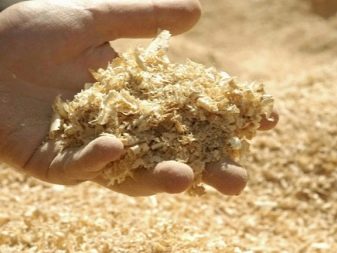
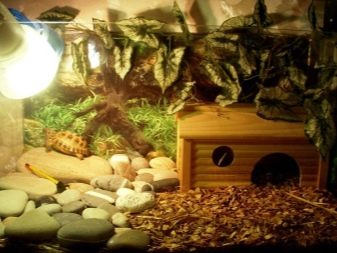
Heating and ultraviolet lamps should be mandatory elements of a terrarium for terrestrial reptiles. In the first case, we can talk about both conventional incandescent lamps and special infrared heat sources. The second element is responsible for UV rays, which are so necessary for the active absorption of calcium.
Original clay houses can become decorative elements of the interior of the land turtle's dwelling. They are also successfully used in the decoration of pebbles, driftwood and other items. All kinds of backgrounds, live and artificial representatives of the flora look no less impressive.
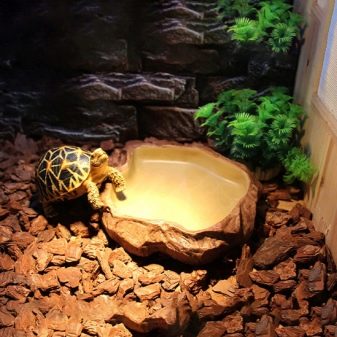

For water
Basically, a water turtle terrarium is just a fairly large aquarium. Its main feature is the equipped land area for the occupant to walk. The best version of an aquatic terrarium will be made of high quality glass. In this case, it will be possible not to worry about the safety of the pets, and also to observe them. The dimensions of the reservoir directly depend on the size and number of inhabitants. The approximate ratio of the size of the turtles (their number) and the volume of the aquaterrarium is as follows:
- the length of the carapace of a reptile within 10 cm - 40 liters;
- from 10 to 20 cm - from 80 to 100 liters;
- two adults - from 120 liters.

The list of mandatory equipment includes:
- internal and external filter elements;
- heating lamp;
- ultraviolet source;
- water heater;
- island
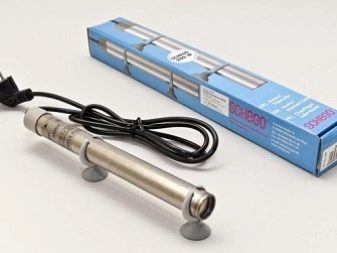
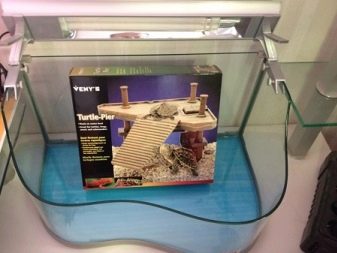
Filters in the terrarium are responsible for the purity and freshness of the water. The devices are the same as in conventional fish tanks. It is important to remember that about a third of the water needs to be changed every week, since reptiles do not differ in cleanliness. The so-called dry land is most often built from pebbles or smooth stones. A ladder is absolutely necessary, along which the turtle will easily get out to the island.
Heating light sources and UV lamps are placed over land. It is in this place that the animal will increase its body temperature and receive the radiation necessary for the production of vitamin D. It is worth noting that the lamps should be on for an average of 12 hours a day. In addition to all of the above, one should not forget about the aesthetic component of the aquaterrarium design. The dwellings of waterfowl turtles are decorated with all kinds of living and natural plants, as well as stones and snags.
If the size of the structure allows, then locks and other fashionable elements of the aquarium interior are often installed.










